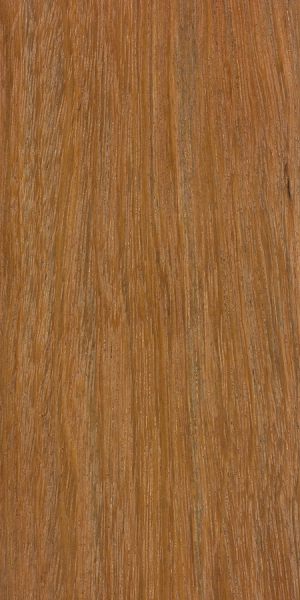Common Name(s): Angelim vermelho, Angelim pedra
Scientific Name: Dinizia excelsa
Distribution: Primarily Brazil and Guyana in South America
Tree Size: 100-200 ft (30-60 m) tall,
3-6 ft (1-1.8 m) trunk diameter
Average Dried Weight: 67 lbs/ft3 (1070 kg/m3)
Specific Gravity (Basic, 12% MC): 0.79, 1.07
Janka Hardness: 3,160 lbf (14,050 N)
Modulus of Rupture: 22,550 lbf/in2 (156 MPa)
Elastic Modulus: 2,811,000 lbf/in2 (19.39 GPa)
Crushing Strength: 12,450 lbf/in2 (85.9 MPa)
Shrinkage: Radial: 5.4%, Tangential: 8.8%,
Volumetric: 14.3%, T/R Ratio: 1.6
Color/Appearance: Heartwood is reddish brown, sometimes with colored streaks; slightly paler sapwood isn’t always clearly demarcated from the heartwood. Freshly sawn surfaces can have a lighter olive hue, with color darkening to a deeper reddish brown with age.
Grain/Texture: Grain is usually interlocked, with a uniform, medium-coarse texture. Moderate natural luster.
Rot Resistance: Rated as durable to very durable, with good resistance to insect attack.
Workability: Considered to be difficult to work on account of its density and irregular grain. The wood also has a high cutting resistance with a pronounced blunting effect on cutters.
Odor: Has a pungent, unpleasant odor when being worked.
Allergies/Toxicity: Although severe reactions are quite uncommon, Angelim vermelho has been reported to cause unspecified allergic reactions. See the articles Wood Allergies and Toxicity and Wood Dust Safety for more information.
Pricing/Availability: Not commonly offered for sale in North America. The wood is sometimes sold as decking or for other outdoor timber applications. Given the immense size of the tree, prices are likely to be reasonable for an imported hardwood.
Sustainability: This wood species is not listed in the CITES Appendices or on the IUCN Red List of Threatened Species.
Common Uses: Heavy construction (exterior applications), flooring, decking, boatbuilding, docks, and other applications where its strength and rot resistance can be utilized.
Comments: Angelim vermelho is yet another example of a very strong and dense tropical hardwood coming from South America. Like most of these hard tropical exotics, it can be a challenge to work, but its durability may be justification to bear with such an uncooperative wood. Additionally, it has quite an offensive odor while it is being worked — and the scent is present both in the green wood and in dried wood.
The phrase “vermelho” in its common name is the Portuguese designation meaning “red;” the wood is also sold or listed as Angelim pedra (pedra means “stone” in Portuguese), though this common name is more commonly applied to timber coming from the Hymenolobium genus.
Identification: See the article on Hardwood Anatomy for definitions of endgrain features.
Porosity: diffuse porous
Arrangement: solitary and radial multiples
Vessels: large, few to very few; dark reddish brown deposits common
Parenchyma: lozenge, confluent, and banded (marginal)
Rays: narrow, normal spacing
Notes: fluoresces under blacklight.
Images:





Really interesting wood; grows up to 88.5 meter high and 9.9 meters in circumference which makes it the tallest tree to have ever been observed in South America.
I made a bench out of this wood and it smells like urine. Is there a way to get this smell out of the wood. It was finished with walrus oil
Thanks!
Tom
Just turned a bowl from this was the hardest wood i ever turned smell not nice can see why its called stone aswell
Would really like to know how many years it takes for one of these trees to mature? If they’re being clear cut vs random harvesting we ALL know that is a BAD practice. Sounds like a species that is endangered & rare to me!
Like many rainforest trees with high density wood it migt take 50 or more years to mature. It has been reported that for example Mahogany dont reach maturity (reproduction) until around 60-70 cm in diameter.
In the amazon, due to the high diversity, trees are harvested selectively and clear cutting is never an option.
Dinizia is not endangered or even vulnerable, according to IUCN its in the lower category.
I got some great discounts on a large amount of spare Pedra decking. The smell was very weird, a cross between rosewood and urine. I thought the wood was on sale because someone pissed on it initially, but eventually the smell went away. The majority of the wood was very dense, but there are portions that soften greatly, to almost as soft as pine.
It has a very interesting pattern and the cathedrals on flat sawn board as amazing
How is your Agelim Pedra decking standing up?